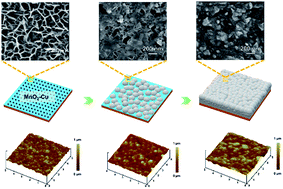A substrate-influenced three-dimensional unoriented dispersion pathway for dendrite-free lithium metal anodes†
Abstract
Lithium dendrites cause poor cycling performance and serious safety hazards, hindering the realization of lithium metal-based batteries. In this study, we developed a new substrate-influenced deposition strategy to turn Li deposits into a 3D unoriented dispersion pathway for dendrite-free lithium anodes. MnO2 nanosheets with high Li+-adsorption-ability were directly grown on the surface of a Cu foil, which could serve as a highly active and highly rough substrate for homogeneous current density distribution and the uniformity of Li-ions. Moreover, after the first discharging process at the pre-treatment stage, uniform LiMnO2 nanocrystals could be reduced in situ, which provided plenty of active sites for Li nucleation. The Li deposition first followed a randomly-oriented 3-D nucleation to adapt itself to the dispersed LiMnO2 nanocrystals. Very fine randomly oriented particles were thus obtained, which could grow and coalesce into a compact Li layer. As a result, the unique 3D deposition pathway could effectively suppress the formation of dendrite and mossy lithium and improve the performance, namely, stable cycling with low overpotential, high coulombic efficiency and long cycling life. This study provides a new avenue for designing a dendrite-free Li metal anode by changing the lithium deposition pathway.



 Please wait while we load your content...
Please wait while we load your content...